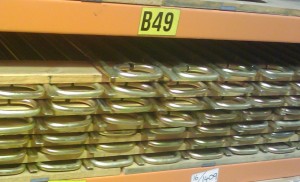 I am sure that you know that risk management is a key aspect of any mature spare parts management process and this is especially so with respect to obsolete inventory.
I am sure that you know that risk management is a key aspect of any mature spare parts management process and this is especially so with respect to obsolete inventory.
Usually, this takes the form of evaluating the risk associated with a stock out – that is not having a required item available when needed.
This is of course an important thing to consider and the evaluation is a key part of most spare parts analysis.
The analysis required for this, typically, uses the standard inventory management theory and techniques – and this is where for spare parts management we hit a problem. In fact there are two problems.
Problems with Obsolete Inventory Analysis
First, inventory management theory relies on an underlying assumption that the item in question will actually move (that is, be sold or used).
This works great if you are a supermarket or major retailer, or wholesaler but is not so certain for spare parts.
In fact, in many situations, you don’t want to use the parts at all!
Plus, the small ‘market’ that this inventory services (being your plant and equipment) means that you don’t get the leveling effect that happens with the larger, more homogenous, markets experienced by goods for production and sale and on which most inventory and supply chain practice is based.
Second, most spare parts management is passive. I don’t mean to suggest that spare parts management is not busy, because it most certainly is; it’s just that that most companies don’t seek to actively adjust their stocks based on changing needs. Spares are often managed on a ‘set and forget’ basis.
Combined, the two problems of underlying assumptions and passive management mean that the risk of holding obsolete stock is far greater that most companies realize.
When you add in the fact that the outcome (obsolete stock requiring a write down) is far removed in time from the initial decision making, is it any wonder that obsolete stocks cause so much heart-ache!
If I had just one dollar for every time I get asked, ‘what can we do about our obsolete stock?’, then I wouldn’t need to work!
The One Solution for Obsolete Inventory Problems
It seems to me that, practically, there is really only one solution to this problem.
Of course you can always get better at the initial decision making but I don’t see that too many people will factor in a potential obsolescence in 5, 10, or 20 years.
Therefore, the only pragmatic approach is to be proactive in your spare parts management every day and improve your process and techniques to actively adjust your stocks based on expected future usage, not historical data, or the initial assumptions.
Our Obsolescence Risk Calculator can provide guidance on where risks might exist and where further investigation or planning may be needed.
For information on our Pro Level membership please visit our Pro Level page.
Posted by: Phillip Slater